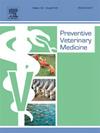Cost assessment of a preventive vaccination program against highly pathogenic avian influenza in Austrian poultry farms
IF 2.4
2区 农林科学
Q1 VETERINARY SCIENCES
引用次数: 0
Abstract
The ongoing global epidemic of highly pathogenic avian influenza (HPAI) has led to the culling of millions of birds across the European Union and beyond. In response, preventive vaccination has been increasingly considered alongside existing measures to control HPAI in poultry. This study focusses on the costs and logistical implications of a potential preventive vaccination program for HPAI in Austrian poultry farms across multiple scenarios, considering different animal and production types, vaccination areas, and vaccination periods. Results show that targeting high-density poultry areas, specific farm types, and seasonal risks can optimize resources and reduce costs. Depending on the scenario, the total cost per vaccinated animal ranges from €1.52 to €4.06. Sensitivity analysis identifies vaccine costs and post-vaccination diagnostics as key cost drivers. The 2024 outbreak season resulted in an estimated €3 million in control-related costs in Austria, with most affected farms located in predefined high-risk zones, highlighting the potential cost-effectiveness of targeting vaccination efforts in these areas. This study provides a basis for policymakers to assess vaccination cost-effectiveness, supporting decisions on implementing an economically viable program to prevent HPAI outbreaks in Austria and other comparable settings.
奥地利家禽养殖场预防高致病性禽流感疫苗接种计划的成本评估
目前全球流行的高致病性禽流感(HPAI)已导致在欧盟内外扑杀数百万只禽鸟。为此,人们越来越多地考虑在现有控制家禽高致病性禽流感措施的同时进行预防性疫苗接种。本研究的重点是考虑到不同的动物和生产类型、疫苗接种区域和疫苗接种期,在多种情况下,奥地利家禽养殖场潜在的高致病性禽流感预防性疫苗接种计划的成本和后勤影响。结果表明,以家禽高密度区、特定养殖场类型和季节性风险为目标,可以优化资源,降低成本。根据情况的不同,每头接种疫苗的总成本在1.52欧元至4.06欧元之间。敏感性分析确定疫苗成本和疫苗接种后诊断是主要的成本驱动因素。在奥地利,2024年爆发季节造成的与控制有关的费用估计为300万欧元,受影响最严重的农场位于预定的高风险地区,这突显了在这些地区开展针对性疫苗接种工作的潜在成本效益。这项研究为决策者评估疫苗接种成本效益提供了基础,支持在奥地利和其他类似环境中实施经济上可行的计划以预防高致病性禽流感暴发的决策。
本文章由计算机程序翻译,如有差异,请以英文原文为准。
求助全文
约1分钟内获得全文
求助全文
来源期刊

Preventive veterinary medicine
农林科学-兽医学
CiteScore
5.60
自引率
7.70%
发文量
184
审稿时长
3 months
期刊介绍:
Preventive Veterinary Medicine is one of the leading international resources for scientific reports on animal health programs and preventive veterinary medicine. The journal follows the guidelines for standardizing and strengthening the reporting of biomedical research which are available from the CONSORT, MOOSE, PRISMA, REFLECT, STARD, and STROBE statements. The journal focuses on:
Epidemiology of health events relevant to domestic and wild animals;
Economic impacts of epidemic and endemic animal and zoonotic diseases;
Latest methods and approaches in veterinary epidemiology;
Disease and infection control or eradication measures;
The "One Health" concept and the relationships between veterinary medicine, human health, animal-production systems, and the environment;
Development of new techniques in surveillance systems and diagnosis;
Evaluation and control of diseases in animal populations.
 求助内容:
求助内容: 应助结果提醒方式:
应助结果提醒方式:


